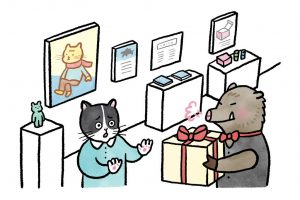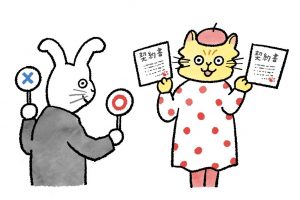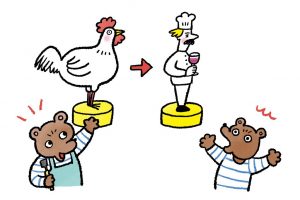Left: Consulter Tamako
Center, Right: Lawyers Maruyama, Kakuta
What if your artwork is damaged at your solo exhibition venue? (Part 1)
Art Emergency Hotline!
No.002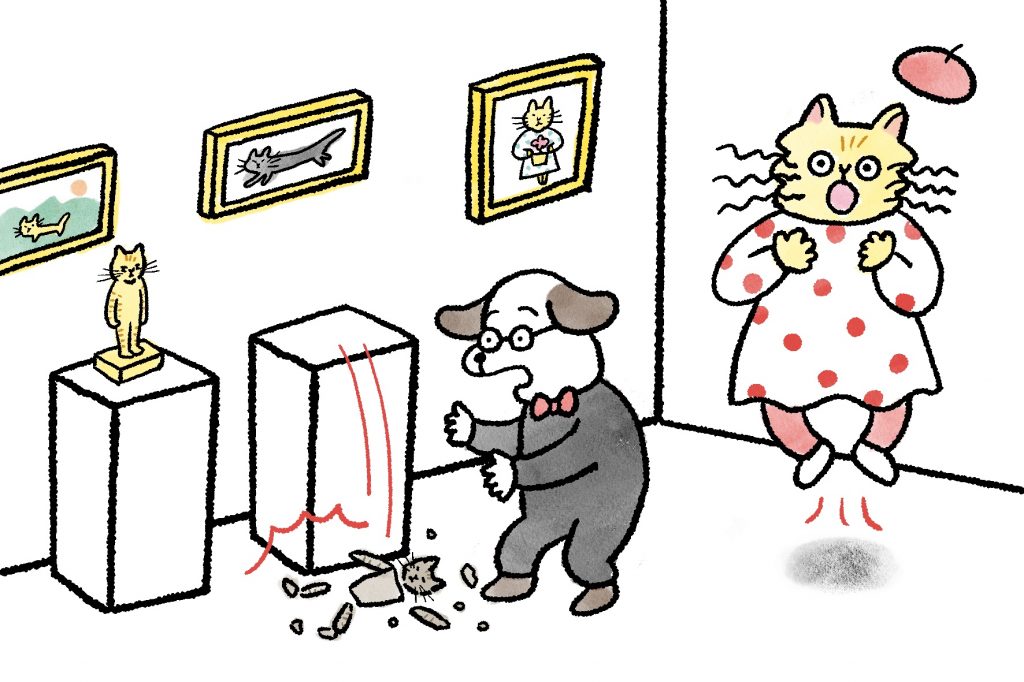
Art Emergency Hotline provides urgent assistance for distressed artists. Several legal professionals answer to a range of consulters each time. The law does not restrict your creative activities, and having the right knowledge can provide vital support.
This time, the consultation is “If a work of art is broken at a solo exhibition venue.” If an audience damages a work of art, how should compensation be considered?
Illustration: Kaeko Akaike
Cooperation and supervision: Arts and Law
Editor: Yoichiro Takemi
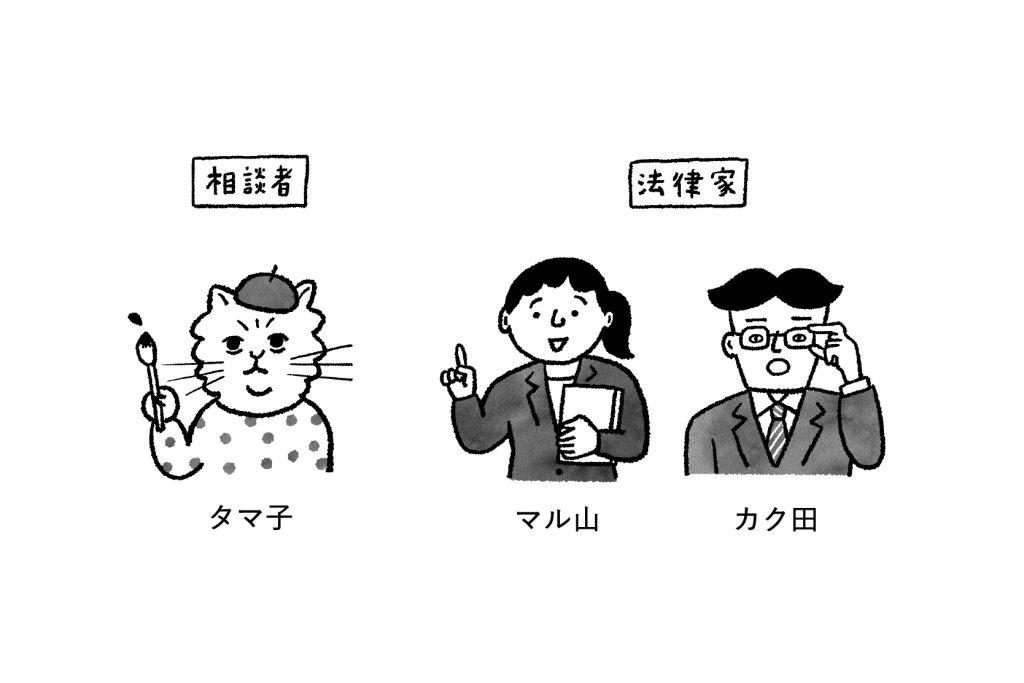
Hello, my name is Tamako and I’m a glass artist. I’m currently holding a solo exhibition, and I had a shocking experience yesterday...
 Tamako
Tamako
 Maruyama
Maruyama
What happened?
During the exhibition opening, one of the guests was holding a work of art in their hands and admiring it, and although it was crowded, their hand slipped, causing the work to fall and shatter into pieces. It was unintentional, and I don’t feel it would be fair to ask the person to pay for it. However, I don’t want to cry myself to sleep.
 Tamako
Tamako
 Maruyama
Maruyama
I see. That must have been a painful accident.
 Kakuta
Kakuta
Let’s examine this together. In such cases, we typically first consider the “percentage of fault.”
Legal term for this installment
Percentage of fault
A numerical representation of the respective responsibility of both parties.
So, when you mention proportion, do you mean who is responsible and to what extent?
 Tamako
Tamako
 Kakuta
Kakuta
The gallery that served as the venue, the individual who caused the damage, and the artist were the three parties involved. You mentioned that the audience member’s hand slipped, but were they permitted to touch the work in the first place?
While there was a sign at the venue entrance stating “Please do not touch the artwork,” there were no warning signs on individual pieces.
 Tamako
Tamako
 Maruyama
Maruyama
In that case, it seems the artist isn’t at fault, and both the gallery and the audience member should be held accountable. However, I believe the gallery has a duty to ensure the safety the work. Should we proceed with this assumption?
The gallery is hesitant to provide compensation, claiming it was just bad luck. In that case, can I seek compensation directly from the person who damaged the work?
 Tamako
Tamako
 Kakuta
Kakuta
We’ll revisit the matter with the gallery shortly, but legally, there’s no obstacle to pursuing compensation directly from the individual responsible. However, the key question here is determining the extent of what’s permissible. Please note that it’s not customary for the full amount to be refunded.
The selling price of the damaged piece was 500,000 yen. My share (wholesale price) would be 250,000 yen if it sold.
 Tamako
Tamako
 Maruyama
Maruyama
If you’re seeking to quantify the value of your work, you might consider the concept of “lost profit.” This entails assessing not only the immediate loss but also the potential future profits that the work could have generated. Mr. Kakuta, would this be analogous to lost earnings in this case?
 Kakuta
Kakuta
I think it is difficult. Typically, lost earnings are associated with cases like permanent disability resulting from a car accident, where the calculation is based on projected earning without the accident. However, in this scenario, it’s uncertain whether we can convincingly argue that various future business opportunities could have stemmed from Ms. Tamako’s lost work. It would essentially be speculative, making it difficult to substantiate.
 Maruyama
Maruyama
The challenging aspect here is that regardless of the amount claimed, Tamako’s side, asserting the damage, must provide documentation and justification. Why specifically 500,000 yen?
 Kakuta
Kakuta
A potential counterargument from the party being held responsible could be, “even if I had not damaged it, the work may not have sold.”
Ugh, that’s awful!
 Tamako
Tamako
 Kakuta
Kakuta
There’s no denying that the work is currently physically damaged, and the effort invested in creating it is evident. If it took you a week to create, you could calculate an average daily rate or assess it based on a cost incurred. However, it would be challenging to match the original selling price.
From an artist’s perspective, the value of a work isn’t determined by an hourly rate or the cost of materials alone. There were works by other artists that were made by sticking a lot of thumbtacks into drawing paper, or gluing dandelion cotton together. It’s fundamentally wrong to solely measure the value of these works based on material expenses.
 Tamako
Tamako
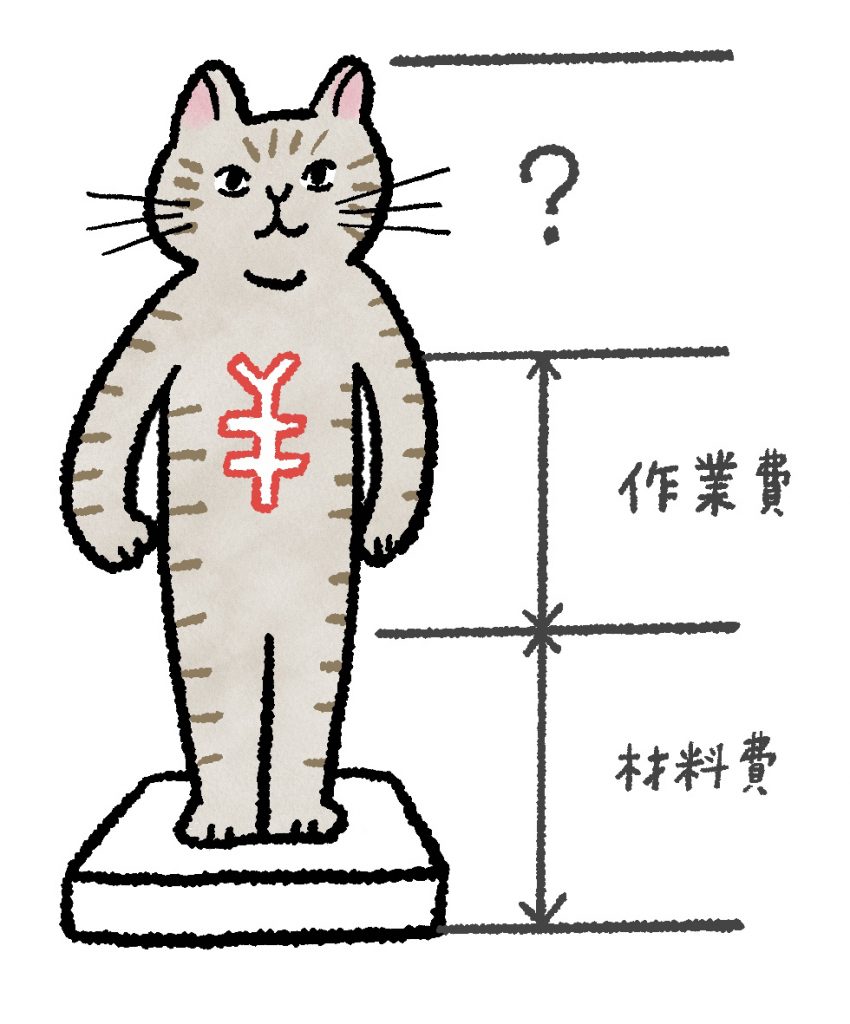
Top: operation cost
Bottom: material cost
 Kakuta
Kakuta
Then, it becomes a matter of market performance.
I’m just starting out and don’t have that many sales examples. What should I do?
 Tamako
Tamako
 Maruyama
Maruyama
In that case, why not consider it in the market price? For example, your career trajectory, past competition awards, and your social media presence, especially if it’s recent. This includes metrics like the number of “likes” on your most recent artist-related posts.
Oh, social media presence could factor in? I’m on Twitter.
 Tamako
Tamako
 Maruyama
Maruyama
For instance, if you have 10,000 followers, comparing prices with artists in the same genre and with the similar follower counts could be helpful.
 Kakuta
Kakuta
There are various methods to argue the value, but as a lawyer, I can only present such arguments; ultimately, it’s up to the judge to decide. Assessing the value of art is inherently complex, and judges may be reluctant to specify a precise amount in their ruling. Instead, they may encourage reconciliation or compromise.
So, there are instances where reconciliation is encouraged in court.
 Tamako
Tamako
 Maruyama
Maruyama
The judge’s role is to make decisions based on the materials and evidence provided by both sides. Without sufficient evidence, it would be challenging to determine an absolute value. As for our discussion in the second part of this column, let’s delve further into the dynamics between the gallery as the exhibition venue and Ms. Tamako.
Arts and Law
Arts and Law (AL) is a non-profit voluntary organization dedicated to planning and implementing support programs for artistic, cultural, and creative endeavors. These programs include a free consultation service, facilitated by qualified professionals such as lawyers, patent attorneys, and accountants.
https://www.arts-law.org (in Japanese)



